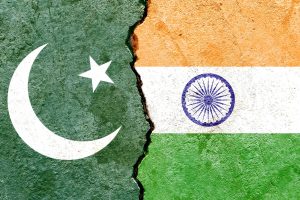On March 11, Indian Prime Minister Narendra Modi tweeted that India had successfully tested an Agni-V missile equipped with Multiple Independently Targetable Re-entry Vehicle (MIRV) technology. MIRV technology can enhance Indian counterforce capabilities vis-à-vis Pakistan.
Moreover, the development of MIRV technology alongside other nuclear advancement programs underway in India, like hypersonic missiles and the ballistic missile defense (BMD) system, further contributes toward changing the Indian nuclear posture from massive retaliation to a pre-emptive strike. The development of MIRV technology by India can therefore have negative implications for the strategic stability between India and Pakistan.
What Is the Agni-V?
Agni-V is a land-based nuclear-capable missile with an estimated range of over 7,000 kilometers, making it an intercontinental ballistic missile. This solid-fueled, three-staged missile was first tested by India in 2012, with subsequent tests over the years. Agni-V is a canisterized missile, in which a nuclear warhead is mated with a delivery system that reduces the time needed to launch the missile.
The missile’s range covers the entire Chinese mainland, including the eastern coast. Further, India has plans to develop an Agni-VI nuclear missile, which will have a range of more than 10,000 kilometers. India is already capable of covering all of China through the Agni-V; the development of the Agni-VI will allow India to cover the entirety of Europe, Asia, Africa, Oceania, and some parts of the United States and Canada.
Recently, India carried out the flight test of an Agni-V missile equipped with MIRV technology off the coast of Abdul Kalam Island in Odisha under the codename Mission Divyastra.
What Is MIRV Technology?
Developed in the early 1960s, MIRV technology permits one missile to deliver multiple nuclear warheads. MIRVed missiles have the capability to release warheads at different speeds and in different directions hitting targets as far as 1,500 kilometers apart. To develop MIRV technology, nuclear warheads have to be miniaturized, equipped with independent guidance and navigation controls, and released sequentially from the delivery system.
MIRV technology can be used for both land-based missiles and sea-based missiles. They are particularly essential for sea-based missiles because of the limited capacity of submarines to carry nuclear missiles – with MIRV technology, an increased number of nuclear warheads can be deployed without increasing the number of missiles.
Another benefit of developing MIRV technology is its ability to counter BMD systems. Launching multiple warheads from the same missile, with their independent trajectories, makes the job of tracking and intercepting them very difficult. Countries are thus developing MIRV technology to counter the BMD systems of their adversaries. Six nuclear-capable countries have developed MIRV technology – the United States, the United Kingdom, France, China, Russia, and Pakistan – and now India is the seventh addition to the club.
Besides being an effective measure against BMD systems, MIRV technology can also be utilized for first-strike options and as a potent counterforce weapon. MIRVs exponentially increase the force ratio for an attack by increasing the numerical advantage over the defending force. An attacker can damage many of the adversary’s defensive forces by using few of its nuclear missiles. With this, the attacker is left behind with a significant force to deter a response.
Moreover, MIRVs can play a significant role in destroying hardened targets by delivering two or more warheads against a single target. All warheads would impact the target within a circle of a few kilometers, thereby destroying them more effectively. Using more nuclear warheads against a single target is more lethal than increasing the nuclear yield of the warhead.
India’s development of MIRV technology is interesting because its adversary, Pakistan, does not have a BMD system. Moreover, even China does not have a very advanced BMD system that India can perceive as a threat.
The development of this capability would only augment Indian counterforce capability and contribute to its already changing nuclear posture – from credible minimum deterrence to a warfighting nuclear posture. India is already developing and upgrading a range of counterforce weapons, including modern missile technologies, hypersonic missiles, BMD systems, dual-capable supersonic missiles, and intelligence, surveillance, and reconnaissance (ISR) capabilities.
Implications for India-Pakistan Stability
Earlier, there were unconfirmed reports that India had conducted a MIRV test for its medium-range Agni-P missile, which has a range from 1,000-2,000 kilometers and can hit targets anywhere in Pakistan. However with the official announcement on March 11, it has been confirmed that India has developed MIRV technology, which can be utilized for other missiles of the Agni series, including Agni-P. India has already inducted the Agni-P into its missile inventory.
Agni-P, a Pakistan-specific Indian missile, has a circular error probable of just 10 meters, making it capable of destroying silos, command and control centers, underground facilities, and strategic missile bases. Agni-P has the latest technology, which was first incorporated into Agni-V: canisterization of nuclear warheads for mating with the missile to decrease its launch time. Moreover, canisterization and quick launch capability would increase India’s ability to launch a first strike against an adversary.
The development of MIRV technology only further eroded the credibility of the Indian no-first-use doctrine, thereby increasing the perception that New Delhi is moving toward a comprehensive first-strike and nuclear warfighting posture. This development is against the declaratory Indian doctrine and is another evidence of a gap between operational Indian doctrine and proclaimed doctrine.
This can increase the nuclear threat perception of Pakistan and force it to take measures to maintain stability in the region. The development incentivizes Pakistan to modernize its own nuclear force by developing an assured second-strike capability aimed at increasing the survivability of its nuclear forces. Further, Pakistan can look toward developing hypersonic missiles, more capable ISR technologies, and other advanced platforms for qualitatively balancing Indian developments. India’s move toward a counterforce targeting strategy and a pre-emptive doctrine are only increasing the risks of advertent or inadvertent nuclear use in the region.
































